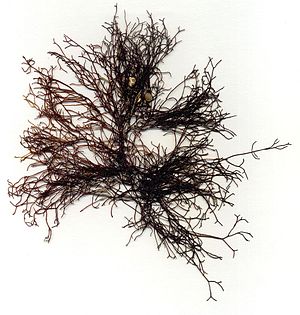Wrinkle wrack
| Wrinkle wrack | ||||||||||||
|---|---|---|---|---|---|---|---|---|---|---|---|---|

Wrinkled wrack ( Ahnfeltia plicata ), |
||||||||||||
| Systematics | ||||||||||||
|
||||||||||||
| Scientific name | ||||||||||||
| Ahnfeltia plicata | ||||||||||||
| ( Hudson ) frieze |
The Faltentang ( Ahnfeltia plicata ) is a type of red algae . It is widespread on the sea coasts and is also found in the North Sea and Baltic Sea. It is used to obtain agar.
description
The wrinkled wrack is easy to recognize with its horny, wire-like branches that often form tangled tufts. Several cylindrical branches with a diameter of 0.5 to 1 millimeter arise from a crust-like basal disk, which branch out very irregularly to almost dichotomously. Their color is brown-violet, black-purple or black, only the blunt end sections are usually light. The thallus tufts are up to 12 centimeters high (rarely up to 20 centimeters).
Development cycle
The wrinkle wrack is a slow growing, perennial species and can likely survive for 5 to 10 years. It goes through three very different generations. The clump of branches is the gametophyte . Male specimens form clusters of spermatangia , which can be seen as thickening of the branches in the central part of the alga. Female specimens form collections of gametangia up to 5 millimeters long on the sides of the axes. After fertilization, the microscopic carposporophyte develops on the female alga . It releases carpospores which germinate on stones and grow into tetrasporophytes . This has the shape of a thin purple crust and was previously thought to be a separate species ( Porphyrodiscus simulans ). There the tetraspores are formed, from which a tufted gametophyte is formed again.
In addition, male gametophytes often have asexual reproduction: monospores are formed in knot-encompassing bumps that develop into new gametophytes. These small humps were also thought to be a separate, parasitic species of algae ( Sterrocolax decipiens ).
Occurrence
The wrinkle wrack is widespread on the sea coasts: in the Atlantic and Pacific , in the Indian Ocean and off the Antarctic . Its main area of distribution is in the northern Atlantic. In the North Sea , it occurs, among other places, near Heligoland and in the North and East Frisian Wadden Sea , as well as in the western and eastern Baltic Sea .
It lives in the lower intertidal zone and in the sublittoral to a depth of 12 meters. There he often colonizes sand-covered rocks and flint stones.
Systematics
The first scientific description was in 1762 by William Hudson under the name Fucus plicatus (In: Flora anglica , p. 470). Elias Magnus Fries placed the species in the genus Ahnfeltia in 1836 , the type species of which is Ahnfeltia plicata .
There are numerous synonyms : Ahnfeltia plicata f. pumila Lakowitz , Ahnfeltia plicata f. tenuior (Lyngbye) Rosenvinge , Ahnfeltia plicata f. tenuis (C.Agardh) Levring , Ceramium plicatum (Hudson) Roth , Fucus albus Hudson , Fucus plicatus Hudson , Fucus plicatus Esper , Fucus plicatus var. simplicior C.Agardh , Gigartina confervoides var. plicata (Esper) Lyngbye , Gigartina plicata (Hudson ) JVLamouroux , Gigartina plicata var. tenuior Lyngbye , Gigartina plicata var. simplicior Lyngbye , Gymnogongrus comosus Kiitzing , Gymnogongrus plicatus (Hudson) Kiitzing , Porphyrodiscus simulans Batters , Sphaerococcus plicatus (Hudson) C.Agardh , Sphaerococcus plicatus var. tenuis C.Agardh , Sphaerococcus plicatus var. simplicior (C.Agardh) C.Agardh , Sphaerococcus plicatus var. elongatus (Turner) C.Agardh , Sterrocolax decipiens F.Schmitz , Tylocarpus plicatus (Hudson) Kiitzing .
use
The wrinkle wrack is an important source of agar , which is widely used as a thickener in the food and cosmetics industries as well as in microbiology. It is harvested mainly in Russia on the coasts of the White Sea and provides high quality agar with a low sulphate content .
Individual evidence
- ↑ a b c Wolfram Braune: Marine algae. A color guide to the common benthic green, brown and red algae of the world's oceans . Ruggell: Gantner, 2008, ISBN 978-3-906166-69-8 , pp. 272, 275.
- ↑ a b c d P. Kornmann, PH Sahling: Sea algae from Helgoland - Benthic green, brown and red algae. Biological Institute Helgoland, Hamburg 1983, ISSN 0017-9957 , p. 197.
- ↑ a b c d Will Rayment (2004): Ahnfeltia plicata. A red seaweed. . Marine Life Information Network (MarLIN): Biology and Sensitivity Key Information Reviews, [on-line]. Plymouth: Marine Biological Association of the United Kingdom. Retrieved April 10, 2019.
- ↑ Michael Guiry: The Seaweed Site: information on marine algae: Ahnfeltia plicata , accessed November 19, 2015.
- ↑ a b c Michael D. Guiry in Michael D. Guiry, GM Guiry: Ahnfeltia plicata - In: Algaebase - World-wide electronic publication, National University of Ireland, Galway, accessed November 19, 2015.
- ↑ Dirk Schories, Uwe Selig, Hendrik Schubert: Species and synonym list of the German marine macroalgae based on historical and recent records (list of species and synomes of macroalgae in German coastal waters - evaluation of historical and recent findings) . In: Rostock. Marine biologist Contribution , Issue 21, 2009, p. 65. PDF file
